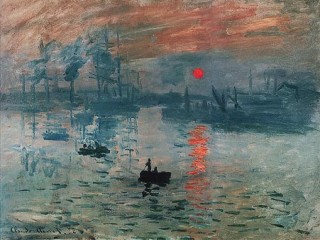
Claude Monet biography
Date of birth : 1840-11-14
Date of death : 1926-12-05
Birthplace : Paris, France
Nationality : French
Category : Arts and Entertainment
Last modified : 2010-07-19
Credited as : Painter, founder of French impressionist painting, famous paintings are Impression and Sunrise
2 votes so far
Early Life and Career.
Claude Monet was born in Paris, the eldest son of a grocer. When Claude was five, the family moved to Le Havre, a port city on the English Channel, where he spent his childhood. The coastline and tempestuous skies of Normandy appear frequently in his later paintings, suggesting that the environment had a formative influence on him. As a teenager he was an accomplished caricaturist. In 1858 a meeting with the painter Eugène Boudin (1824-1898) directed Monet's artistic efforts toward landscape painting in the out-of-doors. As Monet recalled, "All of a sudden, it was like a veil torn from my eyes and I understood at last, I realized what painting could be; thanks to the example of this painter. . . . My own destiny as a painter opened up before me." Within a year he was in Paris studying at the Académie Suisse, and he met Camille Pissarro (1830-1903), another future Impressionist. After serving with the French military in Algeria during 1861 and 1862, Monet returned to Paris, where he became friends with three more future Impressionists: Pierre-Auguste Renoir (1841-1919), Alfred Sisley (1839-1899), and Frédéric Bazille (1841-1870). In 1865, while sharing a studio with Bazille, Monet publicly exhibited two seascapes, and then a year later he won the praise of Emile Zola for Woman in a Green Dress, a portrait of Monet's mistress, Camille Doncieux, who gave birth to their first child in 1867. Despite such critical acclaim, however, Monet was nearly destitute.
The Birth of a Movement.
In 1870, the year in which his friend Bazille was killed in action in the Franco-Prussian War, Monet married Camille and began a decade of prolific painting. While working with Edouard Manet (1832-1883) and Renoir in Argenteuil on the Seine River, the still penurious Monet needed financial assistance from the successful Manet. In 1873 the French Salon rejected paintings submitted by Monet, Pissarro, Renoir, Paul Cézanne (1839-1906), and Sisley for their annual exhibition, prompting Monet and his friends to start their own exhibitions, holding eight between 1874 and 1886. The group called themselves the Anonymous Society of Artists and did not restrict their shows to group members, but an unimpressed reviewer of their first show derisively called them "Impressionists" after Monet's painting Impression: Sunrise (1872), and the name stuck. In fact, despite their differing styles, the artists themselves accepted the label as indicative of at least one of their common aims. At this point Monet began to receive popular and critical acclaim. Some of Monet's best work dates from the 1870s, including his series of Gare Saint-Lazare paintings (1876-1878). One year after the death of Camille Monet in 1879, Monet had a one-man exhibit of eighteen paintings, followed three years later by another solo exhibit in which he presented fifty-six more pictures. He also displayed paintings at the seventh (1882) and the eighth (1886) Impressionist Exhibitions. In 1883 he settled at Giverny in Normandy, renting a house that he eventually bought in 1890, and resided there until his death in 1926. In 1892 he married Alice Hoschedé, who died in 1911.
Monet at Giverny.
In the year he purchased the house in Giverny, Monet began two series of paintings, Poplars and Haystacks. In these paintings he took an approach that he employed often in later works as well: representing the play of light on the same subjects at different times of the day and year (an approach also evident in his Rouen Cathedral series of 1892). Forever an open-air painter, at Giverny, Monet constructed a water garden that was the inspiration for and subject of some of his best-known paintings. In fact, painting the water lilies in his pond occupied him off and on for the rest of his life. In 1899, 1904, and again in 1906 he completed water-lily paintings, spending all 1906 on a single painting, which was exhibited in 1909 to great popular success. In 1910 he painted a new series of them, and in 1916 he began a series of large decorative water-lily panels that were commissioned by Premier Georges Clemenceau. As evidenced by this state commission, the seventy-six-year-old Monet was at the peak of his popularity and influence. By the 1920s Monet was the last surviving Impressionist. (Edgar Degas had died in 1917, Renoir in 1919.) Since 1908 Monet had suffered from impaired vision, and in 1923 an operation for the removal of a double cataract restored enough of his sight for him to complete the panels, his final work. On 5 December 1926, Claude Monet died at Giverny, and the panels were shortly thereafter installed at the Musée de l'Orangerie in Paris in a room especially designed for them.
















